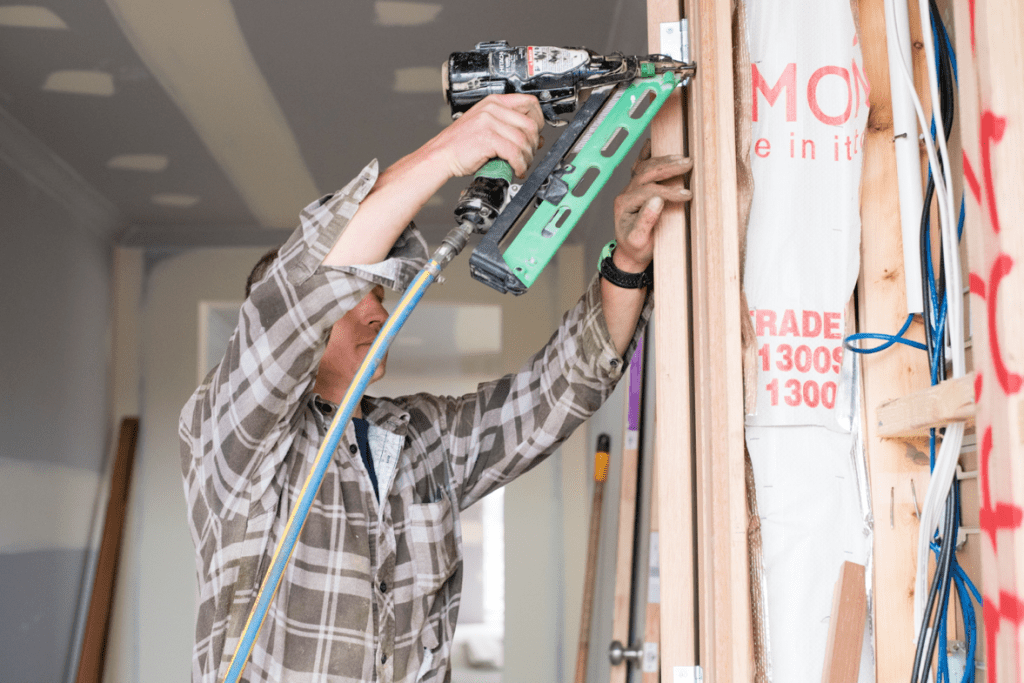TECHNOLOGY AND THE TRADIE LIFE

There was a time (not too long ago) when the idea of a virtual reality helmet made everyone think of Robocop. But these days, digital tools are becoming an everyday reality in the workplace, and the building and construction industry is no exception. How will new technologies affect our working lives over the next few decades, and what impact will they have on employment?
Virtual reality at work
Man and machine: together at last. Last year we looked at emerging uses for drones in our industry, but they’re not the only tech that’s becoming a regular part of life on site. In a recent US survey, 65.3% of respondents named virtual reality as the next big technology trend in construction and design.
Businesses across the sector are starting to invest in virtual reality for on-the-job planning as well as education and OH&S training. The main application for this technology at the moment is the design ‘walkthrough’: a virtual tour of a building that can help identify layout and compliance issues before construction starts.
The use of immersive digital environments to simulate on-site situations is also taking off in education. UNSW Australia, University of Adelaide, University of South Australia and Western Sydney University all use a virtual tool called ‘Situation Engine’ to help students experience real-world construction scenarios. Developed by safety experts, it’s now also being adopted by Australian businesses for their OH&S training.
Beyond walkthroughs and simulations, one of the most exciting uses for augmented reality will be the ability to digitally combine 3D plans with GPS location data so workers can ‘see’ the next stage of an installation—or the location of underground wires and pipes.
A robot for every job?
Last year, WA-based company Fastbrick Robotics made news with its bricklaying robot, which can apparently build a house in two days. The company’s CEO Mike Pivac told the Financial Review that the idea was to have trades work alongside the robots, and to fill the skill shortage in the industry: “We have had many bricklayers come and see what we’re doing and they’re quite excited to work alongside a machine, which would take the heavy lifting out of their jobs and also give them the opportunity to extend their career.”
Investors responded enthusiastically when the company was listed on the ASX, but tradies weren’t so sure. Just a few months earlier, the Committee for Economic Development of Australia (CEDA) had released a report predicting that technology would make almost 40 per cent of Australian jobs redundant within 10 to 15 years.
Responding to the CEDA report, Martin Loosemore, Professor of Construction Management at UNSW said: “The challenge for Australia is to position itself favourably for these changes and to shape the future rather than let it shape us.” This idea was echoed at the recent Construction Leaders Forum, which focused on creating industry growth through innovation.
Finding work
In the short term, there are lots of ways technology is actually improving life for tradies and consumers. Rather than battling Google’s algorithms or worrying about your Yellow Pages listing, you can now register with trade-finder apps such as hipages, which lists more than 65,000 tradespeople and gives them access to more than $1.35 billion worth of jobs each year.
As CHOICE magazine found, there are still some issues with hipages and similar apps – namely that the fees to business for their listings can be quite high, and also that consumers aren’t always aware that by law certain jobs require a licensed tradesperson or building practitioner. These apps do have feedback systems that reward good service-providers though, which make them a solid reputation-building and work-finding tool for small businesses.
Business is booming
Amid all this change, and worry about technology displacing jobs, the latest numbers look really good for Australia’s construction industry. March data from the Australian Bureau of Statistics (ABS) showed that demand for tradespeople is booming. As reported by Sourceable: “[…] The seasonally adjusted number of people employed throughout the construction sector in Australia grew by 18,300 in the February quarter to reach record highs of 1.065 million – around 35,600 more than the same period one year earlier and up by more than 60,000 over the past two years.”
Much of this demand for labour is happening in residential construction. Australia broke ground on 220,060 new homes in 2014/15—a record number—and the Housing Industry Association is expecting figures close to that for the current financial year too. Tech or no tech, it’s never been a better time to be a tradie.
Are you trialing any new technology at work? What’s the verdict? Let us know what you think over on our Facebook page.


